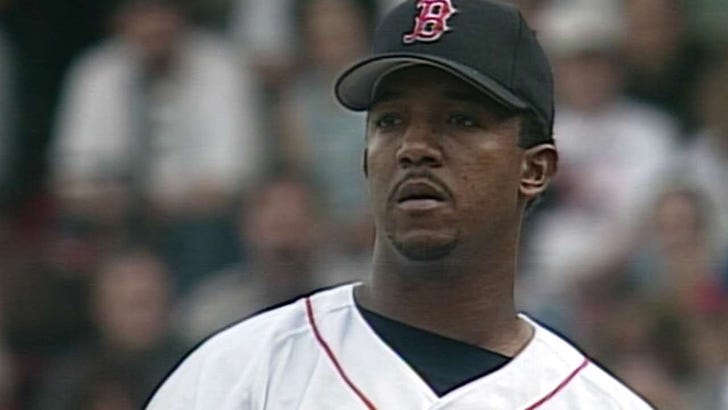Part of the origin story of Under The Knife is a trip to Vegas, of course. Somehow, I always seem to end up at the New York New York casino. Nothing against it in genera, but it’s hardly the best casino, but it’s central, has some good restaurants, and the sports book used to be right on the floor. I ended up there one night, walking through to avoid the Nevada sun, and I saw the tote board.
Pedro Martinez and the Red Sox were -350 against … someone. I honestly forget the opponent, but I knew that Martinez was dealing with a sore shoulder. The team they were playing had a bad record, but some good players and I knew Martinez was likely going to be rusty, bad, or at the very least on a short leash. It was just enough to take the money in my pocket and dropping a sizable amount of it on the other team.
That’s how I always tell the story but in doing so here, I realized Baseball Reference exists. I remember the day was very hot, so it’s no surprise it was August. Martinez wasn’t dealing with a sore shoulder; he was coming off the DL with a rotator cuff strain. It was the Rangers, struggling at 58-73 at the time, who were playing the Sox and ended up winning the game, 5-4. Here’s the boxscore.
I didn’t remember many of the details - the teams, the close score, that Doug Davis was the opposing pitcher - but I do remember coming out of the show that night, looking at the board, collecting my winnings, and eating a really nice meal that night, courtesy Martinez’s shoulder, more or less.
It’s still the way that a lot of people bet games. You look at who’s playing who and who’s starting. Yes, you’re saying “dumb money” out there, but it’s the first thing we al see — teams, starters — and it informs us more than we know. You see “Pedro Martinez” and in 2001, you thought “dominant ace.” You could say the same for a Justin Verlander, Gerrit Cole, or Clayton Kershaw these days.
But did you know that starting pitchers only win about a third of their games? 2015 data is the last I could find checked, but FantasyLabs showed that the win, lose, and not involved are roughly in thirds. I doubt this has changed much over the last few years and it reminds me again that betting the starters is one of the dumbest ways to bet.
Is there a better way to do this? Yes, but let’s take a look at history. The starting pitcher is something that’s existed since Elysian Fields. What we call a ‘starting pitcher’ was often in fact the only pitcher. He’d take the ball at the top and hand it back when the game ended. Relievers were for the weak, or the losers.
Saves didn’t exist until the 1950’s but again, Baseball Reference can look back and teach us. It took until the 1940’s for save leaders to be in double figures, with only the quirky start of Firpo Marberry’s career as the outlier. Marberry was perhaps the first real reliever, pitching behind two aging starters, one of those being Walter Johnson himself. Even then, Marberry was starting other games and putting together a game log that makes modern pitchers twitchy just looking at it.
The 1930’s had pitchers, like Dizzy Dean, who were both starting aces and regular relievers. It was in the post-war era where relievers began to find real work. Roy Face, Ryan Duren, Phil “The Vulture” Regan, and Luis Arroyo existed, but only in place of using starters as relievers on their off-days. They were throwing harder with less of a burden on them.
It’s hard to see this looking at innings totals. All the way until the 1970s, we saw 300 inning starters, but there was beginning to be a big gap between the guys at the top - the outliers and quite often, knuckleballers or Gaylord Perry - and the guy in 10th. Bob Feller threw 371 innings in 1946, just back from the war, but Johnny Sain only threw 265, good for eighth in the league. “Only.”
This gap shrunk and by 1980, the last 300 inning pitcher (Steve Carlton) had almost 50 innings more - an inning and change per start - over 10th place Phil Niekro. That continues down to the point where Justin Verlander, perhaps the last 250 inning pitcher, had only 12 more innings than 10th place. The special ones were still special, but within a much narrower window of opportunity.
I’m not going to argue that innings are a better measure of, well, anything, but if a pitchers job is to get outs, then racking up innings is as good a measure of that as any. Higher pitch counts have been noted among DFS players as an opportunity, but it’s the Pitches Per Out that is more telling. Greg Maddux proved efficiency works in both the short and long term.
Yet even those better measures don’t end up a significant better predictor than starting pitcher wins, which are demonstrably flawed. There’s no one good way to define a system, but any system reliant on pitcher wins is more likely to lose. I won my Pedro bet, but it was luck more than knowledge, even with the injury scoop.




